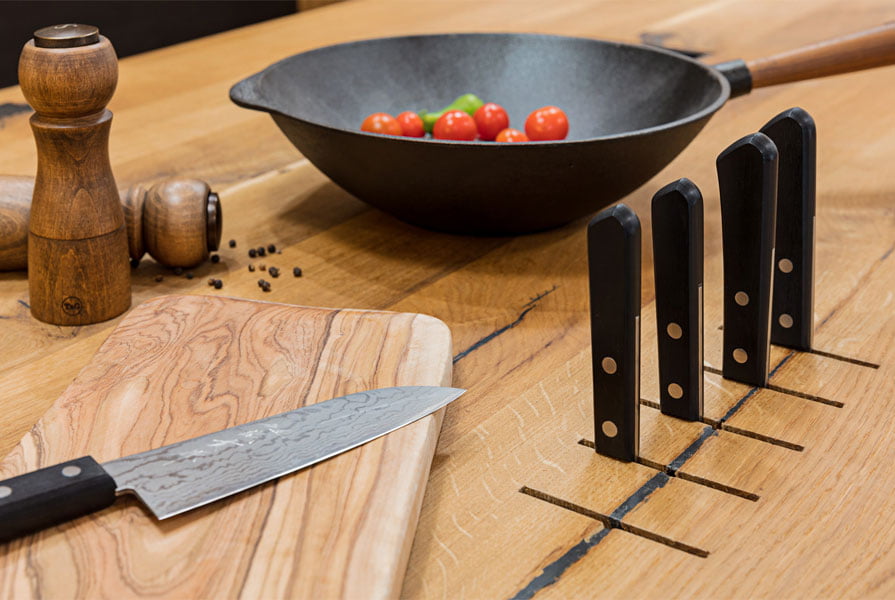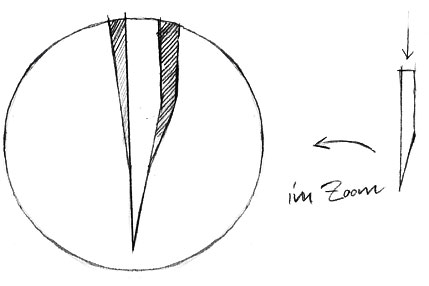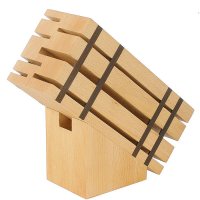
1. Which kind of chopping board should I use?


2. How do I clean rustproof and non-rustproof knives?
Clean the knife by hand, rinsing it under lukewarm water and, if required, adding a little washing-up liquid, and dry it afterwards. Do not use scouring powder and never put the knife in the dishwasher, even if it is rustproof.
3. Which basic equipment?
As a start, we recommend a Santoku (all-purpose knife) plus a Petty (fruit and peeling knife) or a Gyuto (fish and meat knife) up to 150 mm blade length. Extend your equipment following the intended use and your personal preferences.


4. Which knife is the right one?
The right choice of knife depends on the intended use, how much time one is willing to invest in knife care and - last but not least - personal preferences.Come and test a wide range of knives in our shops in Munich and Plattling, we will be happy to advise you
5. How can I protect my non-rustproof knife from oxidation?
Non-rustproof knives can be oiled with camellia oil to protect them from rust, if necessary. Knives must never be left or stored moist or wet. The sooner the knife is cleaned after use, the better it is preserved. This is particularly true when you have cut acidic food like lemons.

Tip: You can also oil the wooden knife handle, if necessary.

6.How do I store the knife?
Prevent the cutting edge from coming into contact with other knives, metals or crockery. Store your knife separately in a knife block, a knife rack or a wooden box. Or follow the example of Japanese cooks who wrap their knives in cloths.
7. Which are the advantages of single-bevelled blades?
This kind of knife features a hollow grind on the flat side of the blade, which creates a kind of air cushion between the blade and the material being cut. The alternating hollowsensure minimal friction and allow for precise filleting and moreaccurate cuts. For this reason, most fish knives are single-bevelled.


8. Which knives are suited for right- and left-handed use?
In general, knives with a double bevel are suited for right- and left-handed use.An edged handle for right-handed use may be uncomfortable for left-handed use.
9. Can I cut bones with my knife?
No, a knife is not suitablefor cutting hard food.Avoid exposing the bladeto breaking, bending andimpact stress. Rough handling can cause the blades to break.

Tip: The blade back of a Deba is suitable for cutting thin bones.

10. How can I keep my knife sharp?
Sharpening courses: a perfect introduction to the art of knife sharpening by visiting one of our one-day sharpening courses held by sharpening experts.
Instruction video: watch our helpful instruction video on sharpening Japanese knives.
Sharpening Primer: Take advantage of ourtips and tricks on knife sharpening in our free . Sharpening Primer.
Sharpening service: You can also send us your knife and take advantage of our Sharpening Service.
11. What cutting technique?
Let the knife glide through the food without exerting much pressure. Use the entire length of the blade and make straight, pulling cuts. Cut soft food like ripe fruit, vegetables, fish and tender meat with a pulling cut whenever possible.The longer the cutting line, the lower the cutting resistance.

Tip: Be kind to your blade and do not push the cut food from the chopping board with the cutting edge — use the back of the blade.

12. Which special knives do I need in the kitchen?
Japanese knives should not be used for anything else other than cutting, trimming and peeling, so you will need a mincing knife for chopping herbs. You will also need a sharp peeler.





